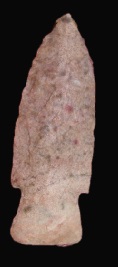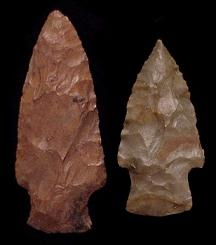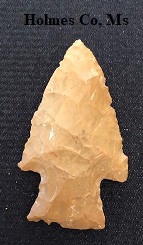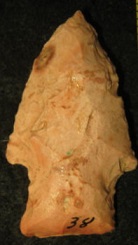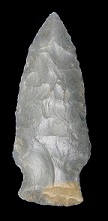Outline is Representative of Size and Shape:

Name Details:
Identified By: David DeJarnette, Edward Kurjack, and James Cambron
Named For: Type Site Location
Date Identified: 1962
Type Site: Cambron Site 53 (Bakers Creek Site), on Bakers Creek, Morgan County, Alabama
Identified By: David DeJarnette, Edward Kurjack, and James Cambron
Named For: Type Site Location
Date Identified: 1962
Type Site: Cambron Site 53 (Bakers Creek Site), on Bakers Creek, Morgan County, Alabama
Point Validity:
Valid type
Dejarnette what the first Anthropologist hired by the University of Alabama and was an expert on southeastern archaeology. Kurjack studied Alabama archaeology as a graduate student at the University of Alabama and went on to become an expert on Mayan anthropology. Cambron is a distinguished avocational archaeologist that did extensive work in Alabama and the Tennessee River valley. This point was named in a professional book. This point has been referred to in numerous professional publications and is considered a valid type.
Baker's Creek Stemmed
AKA: Stemmed Copena (Cambron, 1958)Cluster: Lowe / Steuben Cluster
Description of Physical Characteristics and Flaking Pattern:This is
a small (1.25 to 1.75 inch) triangular stemmed to expanding stem point with a flattened cross section. The blade is primarily straight with a sharp tip. The stem is long and
slightly expanding. The base may range from straight to slightly
convex. This point has a random flaking pattern.
This is
a small (1.25 to 1.75 inch) triangular stemmed to expanding stem point with a flattened cross section. The blade is primarily straight with a sharp tip. The stem is long and
slightly expanding. The base may range from straight to slightly
convex. This point has a random flaking pattern.
Size Measurements:
Length - 25 to 78 mm (45 to 55 mm average), Stem Length - 10 to 18 mm (12 to 15 mm average), Blade Width - 13 to 28 mm (21 mm average), Neck Width - 14 to 22 mm, Stem Width - 21 to 32 mm (23 mm average), Thickness - 7 to 10 mm
Length - 25 to 78 mm (45 to 55 mm average), Stem Length - 10 to 18 mm (12 to 15 mm average), Blade Width - 13 to 28 mm (21 mm average), Neck Width - 14 to 22 mm, Stem Width - 21 to 32 mm (23 mm average), Thickness - 7 to 10 mm
Commonly Utilized Material:
Additional Comments:
This cluster was used in the middle to late Woodland period. These points replaced the large corner notch points (Snyders), and were replaced by Jacks Reef, Intrusive Mound, Knight Island, and Raccoon Creek points (Justice 1987).
Points similar to these (if not the same) found in Florida were named Taylor for the smaller points and Broward for the larger point by Bullen (Schroder, 2013 W18). Similar points found throughout the Ohio River Valley and the Mississippi River valley include Steuben, Lowe, and Chesser points.
This cluster was used in the middle to late Woodland period. These points replaced the large corner notch points (Snyders), and were replaced by Jacks Reef, Intrusive Mound, Knight Island, and Raccoon Creek points (Justice 1987).
Points similar to these (if not the same) found in Florida were named Taylor for the smaller points and Broward for the larger point by Bullen (Schroder, 2013 W18). Similar points found throughout the Ohio River Valley and the Mississippi River valley include Steuben, Lowe, and Chesser points.
Distribution:
Distribution Comments:
This point is primarily found in the Tennessee River Valley and into the Ohio River Valley of western Kentucky. Frequency decreases outside this region in the highlighted areas.
This point is primarily found in the Tennessee River Valley and into the Ohio River Valley of western Kentucky. Frequency decreases outside this region in the highlighted areas.
Age / Periods:
Date: 2,500 - 1,200 B.P.
Cultural Period: Woodland
Glacial Period: Roman Warm to Vandal Minimum
Culture:
Date: 2,500 - 1,200 B.P.
Cultural Period: Woodland
Glacial Period: Roman Warm to Vandal Minimum
Culture:
Age Details:
Similar Points:
Bradford, Broward, Edgewood, Ellis, Flint Creek, Harpeth River, Mud Creek, Swan Lake, Table Rock, Taylor
Bradford, Broward, Edgewood, Ellis, Flint Creek, Harpeth River, Mud Creek, Swan Lake, Table Rock, Taylor





